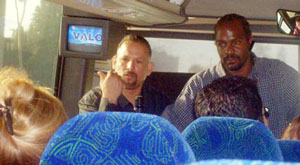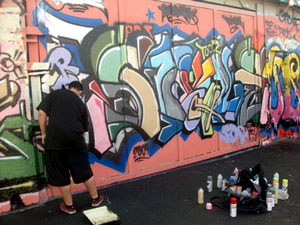CHARLENEM -Western Reg. Correspondent-

LOS ANGELES (FinalCall.com) – Former gang-members have teamed up with a non-profit outreach organization to offer a look at the inner city by conducting gang tours in South Central Los Angeles.
L.A. Gang Tours are designed to raise awareness about the lifestyle of inner city gangs and address the urgent public safety issue presented by gang violence, according to creator Alfred Lomas. The tour costs $65 (down from $100) per adult to get on the bus. Creators of the tours say they want to use the money to create jobs and investment opportunities for micro-lending in some neighborhoods.
The tour has already created 10 jobs and organizers say their immediate strategy is to hire youth from four gangs participating in a cease fire that allows the tours. The groups agreed to no shootings or retaliation shootings between 10 a.m. and 1 p.m. when the busses pass through, said tour organizers.
“Public safety is paramount because without freedom from violence, no other freedoms can exist. … We’ve taken rival kids that would never have an opportunity to see each other outside of probably jail or a gang shooting and this is balanced out with two Hispanics, two Blacks and so on, and so forth,” project coordinator Lomas told The Final Call.

Tour guides Lomas and Fred “Scorpio” Smith gave a brief history of the origination of some of L.A.’s gangs, including the Crips, Bloods and Florencia 13, during a recent tour for reporters. They also highlighted their personal experiences with gangs, and how they entered into intervention and prevention.
Mr. Lomas pointed out historical sites in Los Angeles, as well as notable government facilities. The bus cruised the outskirts of the L.A. River Bed, which was heavily graffiti-tagged, the L.A. County Jail, Olvera Street (considered the birthplace of Los Angeles, Chinatown, Skid Row (which has the largest concentration of homeless population in the U.S.), the Metropolitan Detention Center, several housing projects, and Florence & Normandie, the flash-point intersection of the 1992 rebellion after the acquittal of officers involved in beating motorist Rodney King.
Before stops at the New Life Church of God in Christ and the Pico Union Graffiti Lab, Mr. Lomas explained the different types of graffiti tags and offered a partial viewing of the documentary “Crips and Bloods: Made in America.”
The media route was mostly industrial explained Mr. Lomas, saying tour organizers wanted to maintain the dignity of the residents. The tour has been criticized by those who feel it will negatively display Black and Brown youth and their communities like animals in a zoo.
“It’s going to be nothing like that,” said Mr. Smith, a gang intervention worker in the Jordan Downs Housing area in Watts. “A lot of people have a different view about Watts, South Central, Echo Park, that if you go over there, they are just animals, but we will show it’s nothing like that.”
Rather, he said, tour guides will show the Watts Towers, where the Black Panther Party started, and where the Crips and Bloods street gangs started. During tours people will not be allowed to exit busses at all and no cameras or video/audio recorders will be allowed, according to Mr. Lomas.
According to Kim McGill, an organizer with the Youth Justice Coalition, an advocacy group for incarcerated youth and their families, some youth expressed concerns that these poor communities will serve as field trips for researchers, suburbanites, and Whites. They argue the tours should provide an understanding of urban complexities and a critical analysis of racism.
“Also, it leads to a lot of exaggerations of communities so that you kind of glorify or beef up people’s already preconceived notions about how violent communities are and how everyone’s kind of gangster. As opposed to a situation where you’re really holding wealthier communities accountable for the fact that conditions exist because wealth is not shared, because resources are not equal, because there’s racism in the system, etc.,” Ms. McGill told The Final Call.
Vicky Lindsey, founder of Project Cry No More, a support group for mothers and families who have lost loved ones to gang violence, believes the project is an opportunity for employment and exploitation. Such tours should bring youth contemplating joining gangs up close and personal with the pain involved in the activity, like crying mothers and rehabilitation centers for gunshot victims, said Ms. Lindsay.
“Are they going to go into actual war zones … or gang funerals where family members and people are hurting? In which way is this tour going to impact a youth to say, ‘Oh no, I don’t want to follow gang violence?’” she asked.
“Anything that will help our young people get out of a negative situation is always good, however, on the streets of L.A., you must have a license to operate (LTO) …without the LTO it will be hard to have a successful gang tour. But if the tour creates some form of economics for the hoods that the tour will impact, this is a good thing,” said Ansar Stan Muhammad, co-founder of the gang intervention and prevention Venice 2000/H.E.L.P.E.R. Foundation.












